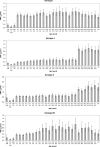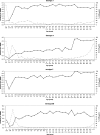Age-stratified prevalences of pneumococcal-serotype-specific immunoglobulin G in England and their relationship to the serotype-specific incidence of invasive pneumococcal disease prior to the introduction of the pneumococcal 7-valent conjugate vaccine
- PMID: 17881503
- PMCID: PMC2168168
- DOI: 10.1128/CVI.00264-07
Age-stratified prevalences of pneumococcal-serotype-specific immunoglobulin G in England and their relationship to the serotype-specific incidence of invasive pneumococcal disease prior to the introduction of the pneumococcal 7-valent conjugate vaccine
Abstract
Recent changes to the childhood immunization schedule in the United Kingdom have resulted in the inclusion of the 7-valent pneumococcal conjugate vaccine. However, the seroprevalence of pneumococcal antibodies in the population was unknown. To address this, we measured pneumococcal, age-specific immunoglobulin G (IgG) concentrations specific for nine serotypes by an assay run on the Bioplex platform, using 2,664 serum samples collected in England from 2000 to 2004. The lowest concentrations of IgG specific to all serotypes and the proportions of serotype-specific IgG concentrations of >/=0.35 microg/ml were observed in children aged <1 year. From 1 year on, there was a general increase in antibody levels with increasing age, and they remained high in adults. Maternal antibody was detected in young children aged <36 days but waned rapidly. Comparison of the age-specific seroprevalence of serotype-specific IgG to the serotype-specific incidence of invasive pneumococcal disease demonstrated a general inverse relationship for all age groups except the elderly. These data provide a baseline for natural immunity to the pneumococcal serotypes analyzed prior to the introduction of pneumococcal conjugate vaccine in the United Kingdom.
Figures




Similar articles
-
Antibody concentrations against the infecting serotype in vaccinated and unvaccinated children with invasive pneumococcal disease in the United Kingdom, 2006-2013.Clin Infect Dis. 2015 Jun 15;60(12):1793-801. doi: 10.1093/cid/civ164. Epub 2015 Mar 3. Clin Infect Dis. 2015. PMID: 25737376
-
Serum and salivary anti-capsular antibodies in infants and children immunized with the heptavalent pneumococcal conjugate vaccine.Pediatr Infect Dis J. 2001 Jan;20(1):25-33. doi: 10.1097/00006454-200101000-00006. Pediatr Infect Dis J. 2001. PMID: 11176563
-
Effect of the 13-valent pneumococcal conjugate vaccine on invasive pneumococcal disease in England and Wales 4 years after its introduction: an observational cohort study.Lancet Infect Dis. 2015 May;15(5):535-43. doi: 10.1016/S1473-3099(15)70044-7. Epub 2015 Mar 20. Lancet Infect Dis. 2015. PMID: 25801458
-
Prevention of pneumococcal diseases in the post-seven valent vaccine era: a European perspective.BMC Infect Dis. 2012 Sep 7;12:207. doi: 10.1186/1471-2334-12-207. BMC Infect Dis. 2012. PMID: 22954038 Free PMC article. Review.
-
Pneumococcal serotype evolution in Western Europe.BMC Infect Dis. 2015 Oct 14;15:419. doi: 10.1186/s12879-015-1147-x. BMC Infect Dis. 2015. PMID: 26468008 Free PMC article. Review.
Cited by
-
Clinical and laboratory characteristics of patients with symptomatic secondary immunodeficiency following the treatment of haematological malignancies.EJHaem. 2023 Apr 1;4(2):339-349. doi: 10.1002/jha2.683. eCollection 2023 May. EJHaem. 2023. PMID: 37206270 Free PMC article.
-
Quantitative Methods for Evaluating Antibody Responses to Pneumococcal Vaccines: A Scoping Review.Trop Med Infect Dis. 2025 Aug 21;10(8):236. doi: 10.3390/tropicalmed10080236. Trop Med Infect Dis. 2025. PMID: 40864139 Free PMC article. Review.
-
Age-related decline in IgM responses associate with reduced opsonophagocytic activity following PCV13 vaccination.NPJ Vaccines. 2025 May 14;10(1):95. doi: 10.1038/s41541-025-01152-7. NPJ Vaccines. 2025. PMID: 40369006 Free PMC article.
-
Serological response to 13-valent pneumococcal conjugate vaccine in children and adolescents with perinatally acquired HIV infection.AIDS. 2014 Sep 10;28(14):2033-43. doi: 10.1097/QAD.0000000000000385. AIDS. 2014. PMID: 25222526 Free PMC article.
-
Impaired innate and adaptive immunity to Streptococcus pneumoniae and its effect on colonization in an infant mouse model.Infect Immun. 2009 Apr;77(4):1613-22. doi: 10.1128/IAI.00871-08. Epub 2009 Jan 21. Infect Immun. 2009. PMID: 19168741 Free PMC article.
References
-
- Black, S., H. Shinefield, B. Fireman, E. Lewis, P. Ray, J. R. Hansen, L. Elvin, K. M. Ensor, J. Hackell, G. Siber, F. Malinoski, D. Madore, I. Chang, R. Kohberger, W. Watson, R. Austrian, K. Edwards, and Northern California Kaiser Permanente Vaccine Study Center Group. 2000. Efficacy, safety and immunogenicity of heptavalent pneumococcal conjugate vaccine in children. Pediatr. Infect. Dis. J. 19:187-195. - PubMed
-
- Brueggemann, A. B., D. T. Griffiths, E. Meats, T. Peto, D. W. Crook, and B. G. Spratt. 2003. Clonal relationships between invasive and carriage Streptococcus pneumoniae and serotype- and clone-specific differences in invasive disease potential. J. Infect. Dis. 187:1424-1432. - PubMed
-
- Chief Medical Officer, Chief Nursing Officer, and Chief Pharmaceutical Officer, Department of Health, London, United Kingdom. 2006. Important changes to the childhood immunisation programme. Professional letters PL/CMO/2006/1, PL/CNO/2006/1, and PL/CPHO/2006/1. Department of Health, London, United Kingdom.
-
- Cockburn, W. C. 1969. World aspects of the epidemiology of rubella. Am. J. Dis. Child. 118:112-122. - PubMed
MeSH terms
Substances
LinkOut - more resources
Full Text Sources
Medical

